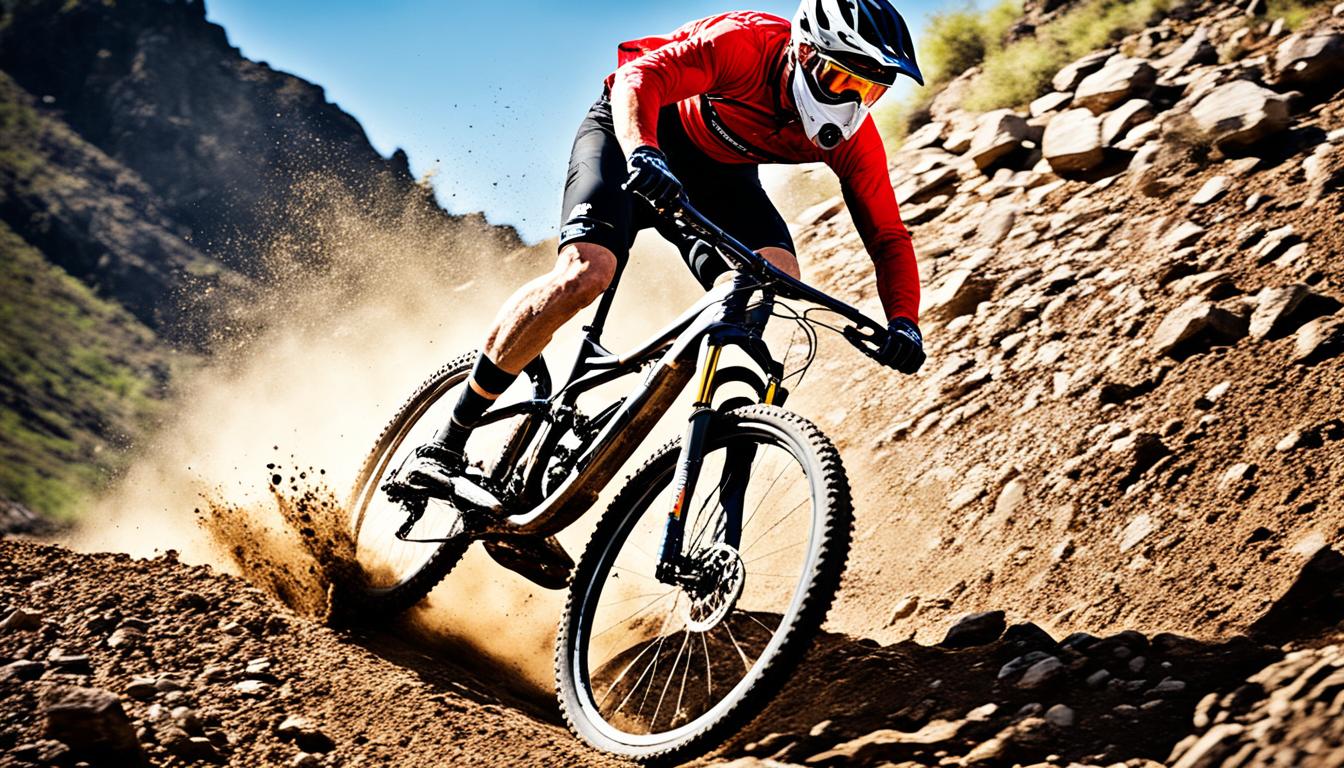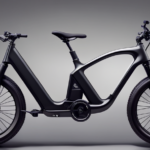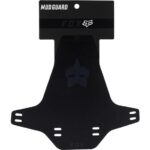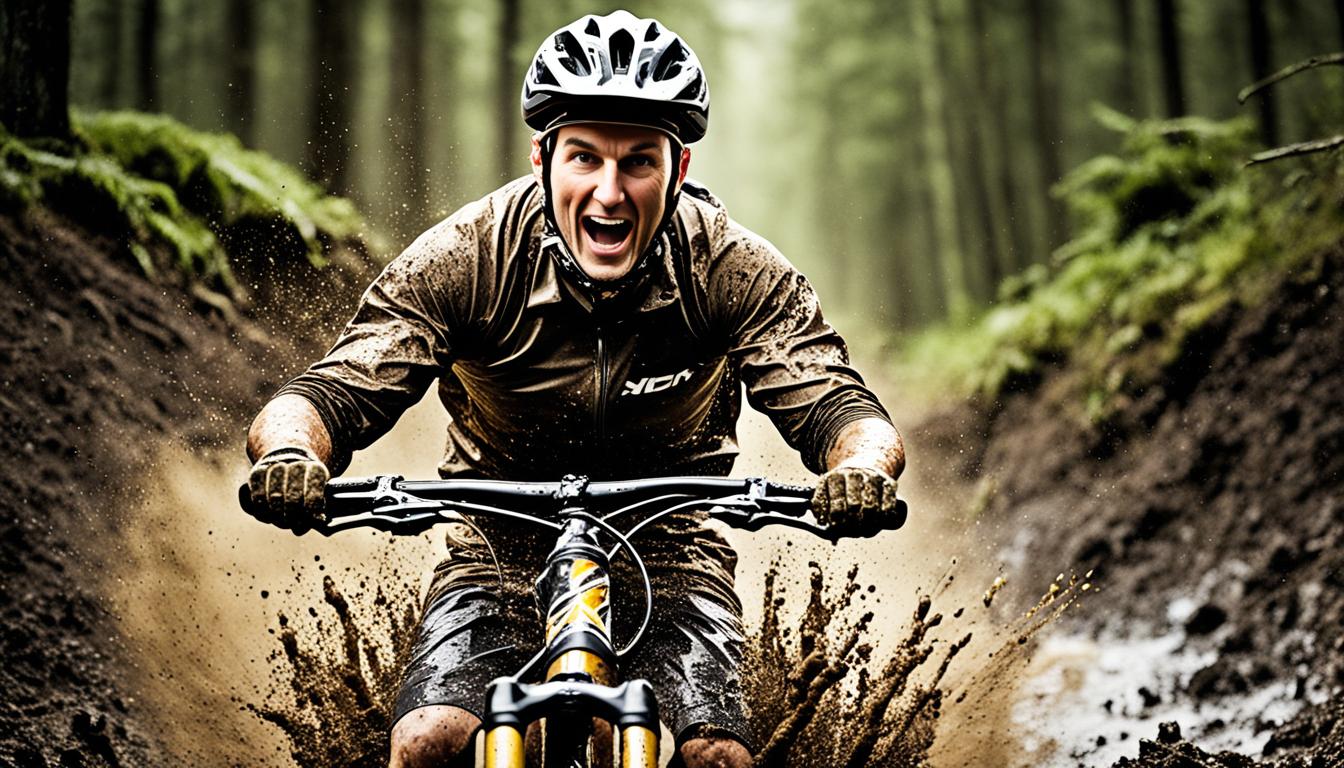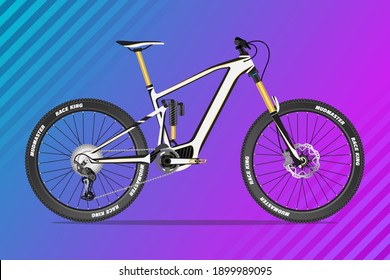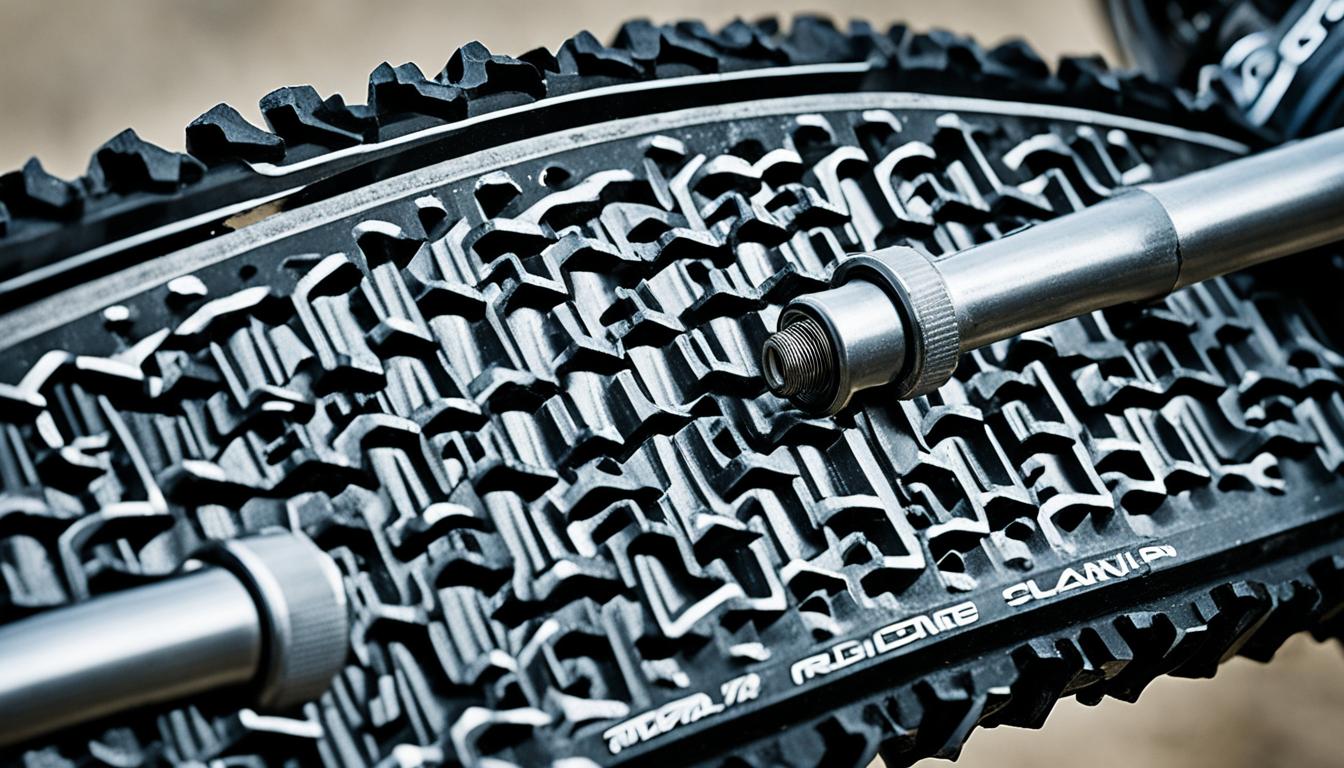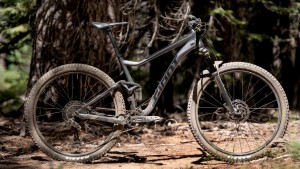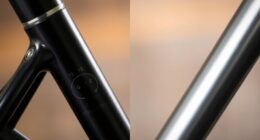Did you know that despite their usefulness in wet conditions, fenders are not commonly seen on mountain bikes? It’s surprising considering how much dirt and debris can be kicked up during off-road rides. In this article, we will explore the practical reasons behind this design choice and what it means for mountain bikers.
Key Takeaways:
- Mountain bikes don’t typically come with fenders due to practical challenges in off-road conditions.
- The tendency for fenders to clog up with mud and debris limits their effectiveness in mountain biking.
- Fit and aesthetic concerns also play a role in why mountain bikes avoid fenders.
- In specialized mountain biking, riders prioritize performance over fender benefits.
- Alternative options like clip-on fenders or mud guards can provide some protection.
The Practicality of Fenders on Mountain Bikes
Fenders serve an important purpose in protecting cyclists from road spray and debris, particularly in wet conditions. However, when it comes to mountain biking, the practicality of using fenders is limited. There are specific challenges and considerations that make fenders less suitable for off-road adventures.
One of the major obstacles is the tendency for fenders to clog up with mud and debris in rugged off-road conditions. As mountain bikers navigate through muddy trails and encounter various types of terrain, the fenders can quickly become packed with dirt, rendering them ineffective. This accumulation of mud and debris not only affects the performance of the fenders but also adds extra weight to the bike, potentially impeding maneuverability.
Furthermore, the aerodynamics of fenders can impact speed and maneuverability, which are crucial factors in mountain biking. Off-road trails often require quick accelerations, sharp turns, and technical maneuvers, and any additional drag from fenders could hinder a rider’s ability to navigate these challenges effectively.
“We often find ourselves riding in wet and muddy conditions, and while fenders may seem like a logical choice for protection, they can quickly become more of a hindrance than a benefit. The constant clogging and added weight can significantly impact our performance on the trails.”
In the world of mountain biking, riders prioritize speed, agility, and responsiveness. While fenders offer protection for wet conditions, the practicality of using them on mountain bikes is overshadowed by their potential drawbacks.
Alternatives to Fenders
Fortunately, there are alternative options available for mountain bikers who still want some level of protection against road spray and debris. Some riders opt for clip-on fenders or shorter mud guards that provide limited coverage without the risk of excessive clogging. These alternative options strike a balance between protection and practicality, allowing riders to enjoy the benefits without compromising their performance.
Additionally, riders can choose to wear appropriate clothing, such as waterproof pants and jackets, to shield themselves from the elements. Accessories like mud flaps or ass savers can also provide some protection without affecting the bike’s aerodynamics.
The decision to use fenders on a mountain bike ultimately comes down to personal preference and the specific requirements of the ride. Some riders may prioritize the added protection and are willing to accept the trade-offs, while others may prioritize performance and choose to ride without fenders, even in wet conditions.

Concerns About Fit and Aesthetics
When it comes to mountain bikes, the absence of fenders can be attributed to concerns about fit and aesthetics. Unlike other types of bikes, mountain bikes are not designed with convenient attachment points or adequate clearance to fit fenders properly. This practical limitation makes it challenging to incorporate fenders into the overall design of mountain bikes.
Furthermore, there is a significant aesthetic consideration at play. Many riders view fenders as visually unappealing on a mountain bike. The sleek and rugged design of a mountain bike is often appreciated for its minimalist and aggressive look. Fenders, with their bulkier form and placement, can disrupt the aesthetics that riders value in their mountain biking equipment.

Addressing the Fit Challenge
Mountain bikes are built with specific parameters to enhance performance and maneuverability in off-road conditions. This means that there is limited space available to accommodate fenders without compromising the bike’s functionality. Manufacturers prioritize weight reduction, frame rigidity, and tire clearance, which may lead to a lack of dedicated fender attachment points.
While some mountain bikes may offer the option to attach fenders through aftermarket accessories, these add-ons can often be cumbersome and hinder the bike’s overall performance. Therefore, adding fenders to a mountain bike may not be a straightforward or practical solution.
Aesthetics and Individual Preference
Mountain biking is a sport that allows for individual expression and personalization. Riders often take pride in customizing their bikes to reflect their own unique style. The addition of fenders may disrupt the overall aesthetic and visual appeal that riders seek.
However, it’s important to note that aesthetics are highly subjective, and some riders may actually find fenders to complement their mountain bike’s appearance. Ultimately, the decision whether or not to use fenders is a personal one, driven by individual preferences and the desire to strike a balance between practicality and aesthetics.
| Concern | Solutions and Alternatives |
|---|---|
| Fit | – Look for mountain bikes with integrated fender mounts – Explore aftermarket options designed specifically for mountain bikes |
| Aesthetics | – Opt for shorter mud guards for minimal coverage – Choose fender designs that match the bike’s style and color scheme |
Specialized Use and Preference
Mountain biking is a thrilling activity that takes riders off-road and onto challenging terrains. When it comes to fenders, their necessity or practicality may vary in this specialized context. Many mountain bikers, particularly those engaged in intense and demanding riding activities, choose not to use fenders due to the specific demands of their riding style. These riders prioritize agility, speed, and maneuverability, making fenders less conducive to their preferences.
Moreover, personal preference also plays a significant role. Some riders simply prefer the feeling of riding without fenders, even in wet conditions. They enjoy the unobstructed connection to the trail, experiencing the full impact of every bump and obstacle. For them, the trade-off between the potential benefits of fenders and the pure mountain biking experience leans towards the latter.
In the world of mountain biking, it’s crucial to recognize the specialized use and individual preference that shape the decision of whether to use fenders. Embracing the essence of this thrilling activity, riders weigh the demands of their riding style and their personal inclinations to make a choice that best suits their needs.
| Specialized Use and Preference: | Advantages | Disadvantages |
|---|---|---|
| Specialized Use | 1. Enhanced agility and maneuverability 2. Unobstructed connection to the trail |
1. Reduced protection against road spray and debris 2. Potential discomfort in wet conditions |
| Preference | 1. Unencumbered riding experience 2. Pure connection with the trail |
1. Potentially compromised protection in wet conditions 2. Higher risk of clothing and bike maintenance |
 |
||
The Impact on Performance
When considering the inclusion of fenders on a mountain bike, one of the primary concerns is the potential impact on performance. As avid mountain bikers ourselves, we understand the importance of speed and agility in challenging terrains. The added weight and aerodynamic drag caused by fenders can have a noticeable effect on these crucial factors.
Mountain biking requires swift maneuverability and the ability to navigate obstacles with ease. Every additional ounce of weight can hinder acceleration and make it more challenging to maintain optimal speed. The extra resistance caused by fenders can also slow down the bike, affecting overall performance.
Fender Weight and Aerodynamic Drag
The weight of fenders varies depending on the material and design, ranging from a few ounces to several pounds. While it may not seem significant, even a slight increase in weight can impact the bike’s responsiveness, especially during climbs or when accelerating. Additionally, the aerodynamic shape of fenders can create drag, further impeding speed and agility.
It’s important to note that the impact on performance may not be the same for every rider. Experienced and professional mountain bikers, who rely on their skill and technique, may be more sensitive to any alterations in bike performance. On the other hand, recreational riders may not notice a substantial difference in their overall riding experience.
Assessing the Trade-off
Ultimately, the decision to use fenders on a mountain bike boils down to personal preference and prioritization. Some riders may prioritize the potential benefits of fenders, such as protection from road spray and debris, over the minimal impact on performance. For others, squeezing out every ounce of performance becomes a top priority, leading them to opt for a fenderless setup.
It’s important to consider your specific riding style, terrain conditions, and personal goals when deciding whether to incorporate fenders into your mountain biking setup. If you frequently ride in wet and muddy conditions, the added protection may outweigh the slight decrease in performance. However, if you primarily focus on speed and agility, you may choose to forego the use of fenders.

| Pros | Cons |
|---|---|
| Protection from road spray and debris | Increased weight |
| Improved visibility in wet conditions | Aerodynamic drag |
| Reduced bike maintenance | Potential impact on speed and agility |
Alternatives to Fenders
While mountain bikes might not come equipped with fenders, there are alternative options available for riders who still want protection against road spray and debris. Let’s explore some of these alternatives:
Clip-On Fenders and Mud Guards
Some riders opt for clip-on fenders or shorter mud guards that provide limited coverage without the drawbacks of full fenders. These alternatives are often easier to attach and remove, making them more convenient for mountain biking. They can still provide some protection against wet conditions, although they might not be as effective as full fenders.
Appropriate Clothing
Another alternative is to wear appropriate clothing that offers protection against road spray and debris. This can include waterproof or water-resistant jackets, pants, and shoe covers. By dressing appropriately for the weather conditions, riders can minimize the impact of wet conditions without the need for fenders.
Mud Flaps and Ass Savers
Additionally, riders can utilize accessories like mud flaps or ass savers. These attachable accessories can help prevent road spray from reaching the rider’s back, providing some level of protection without the need for full fenders. They are lightweight and easy to install, making them popular choices among mountain bikers.
No matter which alternative riders choose, it’s important to consider their specific needs and the conditions in which they ride. Each option has its own advantages and limitations, so finding the right alternative requires personal preference and experimentation.
But wait, there’s more! Here’s a visual comparison of these alternatives:
| Alternative | Pros | Cons |
|---|---|---|
| Clip-On Fenders and Mud Guards | – Easy to attach and remove – Provide some protection against road spray – Can be compatible with different bike models |
– Limited coverage – Might not be as effective in extreme wet conditions – Can collect mud and debris |
| Appropriate Clothing | – Provides overall protection against wet conditions – Versatile and can be used for different activities – No additional attachments required |
– May not offer as much coverage as fenders – May require specific clothing for different weather conditions |
| Mud Flaps and Ass Savers | – Lightweight and easy to install – Provide some protection against road spray – Can be adjusted based on personal preference |
– Limited coverage – May not be as effective in extreme wet conditions – Can still result in some water or debris reaching the rider |

As you can see, there are several alternatives to fenders that mountain bikers can consider. Each option has its own trade-offs, so it’s important to weigh the pros and cons based on individual preferences and riding conditions. Whether it’s clip-on fenders, appropriate clothing, or attachable accessories, riders have options to protect themselves from road spray and debris without the need for traditional fenders.
Considerations for Different Riding Styles
The decision to use fenders on a mountain bike ultimately comes down to individual riding styles and preferences. Some riders who prioritize comfort and protection may opt for fenders, while others who focus on performance and specialized riding may choose to forgo them. It is important for riders to consider their specific needs and the conditions in which they ride when deciding whether or not to use fenders on their mountain bikes.
Different Riding Styles
When it comes to mountain biking, there are various riding styles that riders may adopt based on their preferences and skill levels. These different riding styles can influence the choice to use fenders on a mountain bike.
- Trail Riding: Riders who enjoy riding on established trails may find fenders beneficial, especially in wet and muddy conditions. Fenders can help protect them from spraying mud and debris, keeping them and their bikes cleaner.
- Downhill Riding: Downhill riders prioritize speed and adrenaline, and may choose not to use fenders to maximize their bike’s performance. In this style of riding, fenders can potentially affect a rider’s aerodynamics and maneuverability.
- Enduro Riding: Enduro riders often tackle a combination of uphill and downhill sections, requiring a balance between performance and protection. Some enduro riders may opt for fenders to shield themselves from road spray and debris without compromising their bike’s agility.
Specialized Riding and Fenders
Riders who engage in specialized mountain biking activities may have specific considerations when it comes to using fenders.
“For riders participating in competitions or technical riding, the weight and aerodynamic drag caused by fenders can be a concern. These riders prioritize performance and may choose to forgo fenders to maximize their speed and agility on the trails.”
Seasonal Considerations
The choice to use fenders on a mountain bike can also be influenced by the prevailing weather conditions and riding seasons.
- Wet Seasons: During rainy seasons or in areas with frequent precipitation, fenders can be highly useful in keeping riders dry and minimizing the impact of road spray. Riders who frequently ride in wet conditions may find fenders to be an essential accessory.
- Dry Seasons: In dry and dusty conditions, fenders may not provide as much benefit. Riders in these areas may prioritize other accessories or modifications to enhance their riding experience.
Ultimately, the decision to use fenders on a mountain bike should be based on personal preferences, riding style, and the conditions riders frequently encounter. It’s important to weigh the advantages and disadvantages to ensure the best riding experience for each individual.

| Riding Style | Pros of Using Fenders | Cons of Using Fenders |
|---|---|---|
| Trail Riding | Protection from road spray and debris Keeps rider and bike cleaner |
Potential for clogging in muddy conditions May affect bike’s aerodynamics |
| Downhill Riding | Unobstructed bike performance Maximized speed and maneuverability |
No protection from road spray and debris Increased exposure to flying objects |
| Enduro Riding | Partial protection from road spray and debris Balance between performance and comfort |
Potential for clogging in muddy conditions Slight impact on bike’s aerodynamics |
The Benefits of Fenders on Gravel Bikes
While mountain bikes may not commonly have fenders, it is worth noting that gravel bikes, which share some similarities with mountain bikes, often come equipped with fenders. This is because gravel biking involves a mix of road and off-road riding, making fenders more practical in wet and muddy conditions.
When riding a gravel bike, fenders offer several benefits:
- Improved Comfort: Fenders help reduce the amount of road spray and debris that can be kicked up while riding, providing a more comfortable and enjoyable experience.
- Protection from Road Spray: Fenders shield both the rider and the bike from the spray of water, mud, and other particles that can be present on wet or muddy roads. This helps keep the rider cleaner and prevents unnecessary damage to the bike.
- Reduced Maintenance: By minimizing the amount of dirt and grime that comes into contact with the bike components, fenders can help reduce the frequency of maintenance tasks such as cleaning and lubricating.
Overall, fenders on gravel bikes contribute to a more pleasant and hassle-free riding experience, allowing cyclists to tackle a variety of terrains without having to worry about the effects of wet conditions. Whether it’s a leisurely ride or a challenging gravel race, fenders offer practical advantages for gravel bikers.

“Having fenders on my gravel bike has been a game-changer. I no longer have to deal with the constant spray of water and mud, and my bike stays cleaner for longer. It’s made riding in wet conditions much more enjoyable and worry-free.” – Sarah, avid gravel cyclist
Conclusion
In conclusion, the absence of fenders on mountain bikes can be attributed to several factors. The practical challenges faced in off-road conditions, including the tendency for fenders to clog up with mud and debris, make them less practical for mountain biking. Additionally, the impact on performance, in terms of added weight and aerodynamic drag, is a concern for many riders who prioritize speed and maneuverability.
Fit and aesthetics also play a role in the absence of fenders on mountain bikes. Bikes designed specifically for mountain biking may lack the necessary attachment points or clearance to properly accommodate fenders. Moreover, some riders have aesthetic concerns and find fenders visually unappealing on their mountain bikes.
However, it is essential to consider individual riding styles and preferences when deciding whether or not to use fenders on a mountain bike. While they may not be common in mountain biking, fenders have their place in other cycling disciplines and can provide valuable benefits in specific riding conditions. Ultimately, the decision to use fenders on a mountain bike should be based on the rider’s specific needs, the conditions in which they ride, and their personal preferences.
